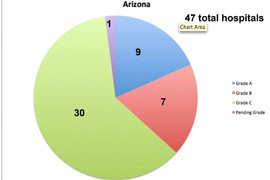Cronkite News has moved to a new home at cronkitenews.azpbs.org. Use this site to search archives from 2011 to May 2015. You can search the new site for current stories.
Arizona hospitals fare poorly in national survey of patient safety
WASHINGTON – More than half of the 47 Arizona hospitals ranked in a recent survey of patient safety got a grade of C, the lowest grade offered in the first year of the national report.
The survey by the Leapfrog Group measured 26 patient-safety factors, everything from the hospital’s computer system to how often catheters are removed and even the frequency of surgeons accidentally sewing up a patient with an object left inside.
Arizona was one of nine states where about two-thirds of hospitals earned a C in the survey. The survey evaluated 2,651 hospitals nationwide, and 1,111 hospitals received a C grade.
In Arizona, 30 hospitals got a C, seven got a B, nine got an A and one got a “pending” score, giving it time to pull its grade up from below C.
A spokesman for the Arizona Hospital and Healthcare Association challenged the report, saying he hopes Leapfrog “would improve the methodology” before the next report. But he also said hospitals in the state would look at the report and address any problems it identifies.
“We have not received any positive feedback about how they did this survey or the methodology,” said the association spokesman, Peter Wertheim. “But it’s a laudable goal and one that hospitals support.”
The survey graded hospitals on 26 different categories of patient safety that the hospitals were asked to voluntarily report. Because of that, some hospitals were graded on more data than others.
“It’s patently unfair to hospitals, because they’re getting scored on fewer elements,” Wertheim said of some facilities.
The survey is part of an initiative by the nonprofit Leapfrog Group to reduce preventable hospital mistakes, which it said claims more than 400 lives every day.
“Even if you have the best heart surgeon in the world, if the hospital isn’t safe, your trip was in vain,” said Leapfrog spokeswoman Erica Newman.
The most important factor in the survey was a hospital’s computer system. Newman said that is the same system that would tell a staff member he is giving a 12-year-old an adult dose of a medication or fatally mixing two different medications.
Newman conceded that the amount of information a hospital provided may affect its grade, but she said the survey tried to balance that by weighting patient-safety criteria and by not giving a grade to those with too much missing data.
Hospitals could submit as much information as they would like, or not participate at all, she said.
“Of course, the more measures they have, the least likely that one bad measure will influence their score in a negative way,” Newman said. “We did consult multiple secondary data sources to give hospitals as much credit as possible towards their score.”
Leapfrog will reissue grades in November, giving hospitals a chance to improve their scores, before they hand out D and F grades.
While some Arizona hospitals told Wertheim they were less than pleased with how the survey was conducted, at least one that did well was grateful to be recognized for its safety efforts.
“We’re very excited about it,” said Patricia Patterson, a spokeswoman for Payson Regional Medical Center. It was one of the nine Arizona hospitals to get an A.
“It (patient safety) is always a focus for us,” Patterson said.
Newman said Leapfrog hopes patients will use the information in the survey when they pick a hospital.
“We hope that patients will ask their hospitals, ‘Why aren’t they getting an A?’ and ‘How are they going to fix that?’” Newman said.
Wertheim said that while “people are going to see it and use it,” he urged patients to rely on more than the survey when considering a hospital’s safety.
“You can use these report cards, but certainly ask questions of the hospital and of the doctors and investigate yourself as well,” Wertheim said.







